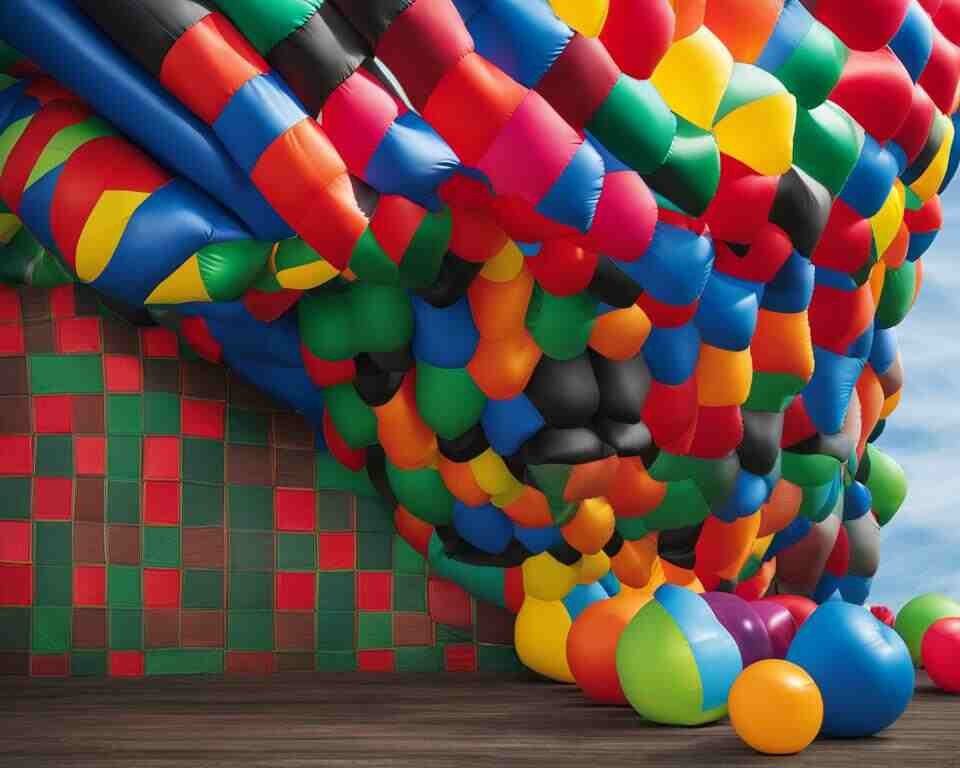Inflatables have gained widespread popularity for a myriad of uses, ranging from recreational activities to advertising and even construction. But, what are inflatables made of? Exploring the composition of inflatables is crucial to truly grasp their robust construction and incredible versatility.
In this article, I will explore the diverse materials used in the production of inflatables and explore how these materials contribute to their durability and functionality.
Key Takeaways:
- Various materials are used in the production of inflatables, including fabrics, plastics, rubber, and specialty materials.
- The selection of materials depends on the intended use of the inflatable.
- Different construction techniques, such as welding, stitching, or heat-sealing, are used to create these airtight structures.
- Durable materials with high tear strength, abrasion resistance, and UV protection make for longer-lasting inflatables.
- Eco-friendly options like recyclable PVC, biodegradable TPU, or natural fabrics are now available for more environmentally-conscious consumers.

The Role of Fabric in Inflatables
Fabric plays a critical role in the production of inflatable products, as it provides the required structural integrity and flexibility. The choice of fabric influences the durability, weight, and resistance of the final product.
The most commonly used fabrics are PVC-coated nylon or polyester, known for their high strength, tear resistance, and ability to withstand repeated inflation and deflation.
The inflatable manufacturing process involves cutting and sewing the fabric into various shapes and sizes to create bespoke structures suitable for different applications.
Inflatable fabric is selected based on its purpose, whether it’s for indoor or outdoor use, and the specific requirements of the product. Indoor inflatables may not require UV or moisture resistance, making polyester fabric a suitable choice.
Inflatable fabric can also be customized to suit the needs of different applications by using multiple layers or coatings. Interior liners, for instance, can be added to enhance strength, maintain air pressure, and extend the life of the inflatable product.
Fabric Used in Different Types of Inflatables:
| Product Type | Fabric Used |
|---|---|
| Inflatable Boats and Rafts | Natural or Hypalon synthetic rubber compounds or PVC |
| Air Mattresses and Toys | PVC coated nylon or polyester |
| Promotional Inflatables | Nylon, PVC, or coated polyester fabrics |
| Outdoor Inflatables | UV-resistant PVC, reinforced polyester, or coated fabrics |
Exploring Inflatable Plastic
Inflatable plastic is a widely-used material in the manufacturing of inflatables. PVC (Polyvinyl Chloride) stands out due to its versatility, water resistance, and ease of cleaning. Its lightweight nature makes it ideal for creating portable inflatable products such as air mattresses and toys.
The manufacturing process of inflatable plastic involves heat-sealing or welding the plastic sheets together to create airtight compartments. The resulting inflatable is strong and durable, owing to its ability to withstand wear and tear associated with frequent inflation and deflation.

The use of inflatable plastic has enabled manufacturers to produce different shapes and sizes of inflatables that are affordable, yet robust in structure. The versatile material can take on complex designs and colors, making it an ideal choice for creating inflatables suitable for a broad range of applications.
The Strength of Inflatable Rubber
When it comes to manufacturing sturdy and durable inflatables, inflatable rubber is a popular material choice. Whether it’s natural rubber or synthetic rubber compounds, their elasticity, durability, and resistance to wear and tear make them suitable for various applications.
The manufacturing process involves molding the rubber into the desired shapes and reinforcing areas prone to stress or impact, creating airtight compartments that resist air leaks.
Overall, inflatable rubber is a reliable material that ensures the manufacturing of robust inflatables that remain resilient in different situations.
Advantages of Inflatable Rubber
| Advantages | Description |
|---|---|
| Elasticity | Rubber is flexible and able to bend and stretch without breaking, making it ideal for inflatable manufacturing. |
| Durability | Thanks to its sturdy composition, inflatable rubber can withstand daily wear and tear. |
| Resistance to water exposure | Rubber is a resilient material that can tolerate exposure to different water-based environments without losing its shape or buoyancy. |
| No air leaks | Rubber’s airtight compartments help maintain the inflatable’s form and prevent air leaks, ensuring reliability in use and safety for the user. |
Specialty Materials for Outdoor Inflatables
When it comes to outdoor inflatables, the materials used must withstand harsh weather conditions, UV rays, and moisture. That’s why specialty materials such as UV-resistant PVC, reinforced polyester, and coated fabrics are commonly used.
UV-resistant PVC is a durable material that can withstand exposure to sunlight, making it ideal for outdoor inflatables. The material is known for its water and abrasion resistance, flexibility, and toughness.
Reinforced polyester is another excellent option for outdoor inflatables, providing strength, durability, and resistance to tear and wear. Additionally, coated fabrics offer additional protection against environmental factors and moisture and are easy to clean.

With the right specialty materials, outdoor inflatables can maintain their durability and longevity, ensuring they withstand exposure to harsh outdoor elements.
Inflatable Materials for Water Activities
When it comes to water activities, inflatables need to be made of materials that can withstand water exposure and provide buoyancy. Hypalon, Neoprene, and PVC-coated polyester are some of the most commonly used materials for inflatable watercraft such as kayaks, rafts, and stand-up paddleboards.
Hypalon is a synthetic rubber material known for its excellent resistance to UV radiation, corrosion, and chemicals. Hypalon-coated fabrics offer high tear strength, flexibility, and resistance to extreme temperatures, making it an ideal choice for watercraft.
Neoprene is a versatile synthetic rubber material that is impermeable to water and air, providing excellent buoyancy characteristics. It is also resistant to UV radiation and harsh weather conditions.
PVC-coated polyester is a lightweight and durable material that is commonly used for inflatable watercraft such as kayaks. PVC offers excellent resistance to abrasion, punctures, and tearing.
The proper selection of materials for water inflatables is crucial to ensure safety and performance. Advanced Elements, and AquaGlide are some of the companies that provide quality inflatable watercraft made of durable materials.
Materials for Advertising Inflatables
When it comes to advertising inflatables, materials play a crucial role in the overall quality of the finished product. With the primary aim of promoting a brand or product, the chosen materials should not only be visually appealing but also durable and easy to print on.
Common materials used in the creation of advertising inflatables include nylon, PVC, or coated polyester fabrics. These materials are ideal for creating eye-catching shapes and vibrant graphics that can withstand the outdoor conditions, making them perfect for promoting products or events.
The durability of these materials allows for printing of high-resolution images that remain clear, visible, and vibrant throughout the lifespan of the inflatable. Nylon, PVC, and coated polyester fabrics also offer excellent resistance to wear and tear, making sure that advertising inflatables can withstand frequent transport, repositioning, and exposure to various weather conditions.

Advertising inflatables provide businesses with a cost-effective, creative way to promote their brand in a crowded marketplace.
High-quality materials play a vital role in ensuring that advertising inflatables offer a strong visual impact, increased visibility, and are durable and resistant for a more extended period.
By using such materials in constructing advertising inflatables, companies can get their brand noticed and create a long-lasting impact on customers.
Eco-Friendly Inflatable Materials
In recent years, eco-friendly inflatable materials have gained popularity due to the growing concern over the impact of plastics on the environment.
Manufacturers now offer a range of eco-friendly options that aim to reduce the environmental impact while ensuring the durability and performance of inflatables.
These materials are sustainable, non-toxic, and energy-efficient in their production, making them an ideal choice for conscious consumers.
In addition, these eco-friendly materials often have superior UV resistance, water resistance, and flexibility, making them suitable for various inflatable applications.
Inflatable Construction Techniques
When it comes to the construction of inflatables, the manufacturing process is just as crucial as the materials used. The right technique can ensure maximum durability and longevity for the final product. Let’s take a closer look at some of the most common inflatable construction techniques:
Welding
Welding techniques involve using heat and pressure to fuse together the different materials of the inflatable. This results in an airtight seal that is incredibly strong and resistant to wear and tear. For example, High Frequency Welding is widely used in inflatable manufacturing as it provides a reliable and robust seal.
Stitching
Stitching techniques involve threading together the different parts of the inflatable using heavy-duty needles and threads. It is a popular choice for smaller inflatables or those with intricate designs as it offers flexibility and allows for the creation of complex shapes and patterns.
Heat Sealing
Heat-sealing involves using a heated press to melt together the different materials of the inflatable. This creates a strong, airtight seal that is highly durable and ideal for larger inflatables. Heat-sealing is widely used for PVC-based inflatables as it allows for precise and secure sealing of the material.
The Inflatable Manufacturing Process
The inflatable manufacturing process is highly complex and requires a combination of skilled craftsmanship and advanced technology. It involves cutting and shaping the different materials before joining them using welding, stitching, or heat sealing techniques. The inflatable is then inflated and checked for any leaks or defects before being packaged for shipment.
Summary
The construction of inflatables involves a careful selection of materials and techniques to ensure maximum durability and functionality. Welding, stitching, and heat-sealing are commonly used techniques to join the different parts of the inflatable and create airtight compartments. The inflatable manufacturing process is highly complex and involves a combination of skilled craftsmanship and advanced technology to produce high-quality inflatables.
Selection of Durable Materials in Inflatable Design
Choosing the right materials for inflatable design is crucial for ensuring longevity and safety. In order to create the best inflatables, materials must have properties such as high tear strength, abrasion resistance, and UV protection, depending on the specific application of the inflatable.
Inflatable materials for durability are essential components used in construction. Some of the best materials for inflatables that offer excellent structural integrity and multi-purpose use include PVC-coated nylon and polyester.
When it comes to inflatable construction materials, it is essential to consider the intended use of the inflatable. If an inflatable is meant for industrial use, materials with high impact resistance and rugged construction are preferred. For recreational purposes, materials with strong resistance to wear and tear, such as Hypalon, Neoprene, and PVC-coated polyester, are ideal for inflatable watercraft like kayaks, rafts, and stand-up paddleboards.
The durable materials for inflatables should also be selected based on the environment where the inflatable is to be placed. If placed outdoors, it is advisable to choose materials that are resistant to UV rays, moisture, and other environmental factors. Besides, considering eco-friendly materials like recyclable PVC, biodegradable thermoplastic polyurethane (TPU), or natural fabrics like cotton canvases helps to reduce the environmental impact of inflatable production.
When designing inflatables, choosing the best materials plays an integral part in creating long-lasting and safe products that meet specific needs.
Conclusion
Now that we have explored the diverse materials used in inflatable production, we can appreciate their impressive properties and versatility. From sturdy fabrics and plastics to durable rubber and specialty materials, each component plays a crucial role in the inflatable’s strength, flexibility, and durability.
With advances in technology and eco-conscious practices, the industry continues to develop new and innovative materials that minimize the environmental impact of inflatable production.
Whether for recreational purposes, advertising, water activities, or construction, selecting the right materials for the specific application is essential to achieving maximum performance and longevity.
Manufacturers use a combination of skilled craftsmanship and advanced technology to ensure the inflatable’s integrity and safety, from the welding, stitching, or heat-sealing processes to the selection of durable materials.
Overall, understanding what inflatables are made of gives us a glimpse into the intricacies of their construction and the science behind these versatile products.
FAQ
What materials are inflatables made of?
Inflatables are made of various materials depending on their intended use. Common materials include fabric (such as PVC-coated nylon or polyester), plastic (typically PVC), and rubber (natural or synthetic compounds). Specialty materials may also be used for outdoor inflatables, water activities, advertising inflatables, or for eco-friendly alternatives.
How does fabric contribute to the construction of inflatables?
Fabric plays a crucial role in providing structural integrity and flexibility to inflatables. PVC-coated nylon or polyester fabrics are commonly used due to their strength and resistance to tearing. They are cut and sewn into different shapes during the inflatable fabrication process.
What is inflatable plastic and how is it used?
Inflatable plastic, typically PVC (Polyvinyl Chloride), is widely used in the manufacturing of inflatables. PVC offers versatility, water resistance, and easy maintenance. Plastic sheets are heat-sealed or welded together during the manufacturing process to create airtight compartments in the inflatables.
What role does inflatable rubber play in the construction of inflatables?
Inflatable rubber, either natural or synthetic compounds, is used for its elasticity, durability, and resistance to wear and tear. Rubber-based inflatables are commonly found in water activities and are molded into the desired shapes through the manufacturing process.
Which materials are used for outdoor inflatables?
Outdoor inflatables require additional protection against UV rays and moisture. Specialty materials such as UV-resistant PVC, reinforced polyester, or coated fabrics are commonly used to ensure durability and longevity in outdoor conditions.
What materials are suitable for water activities in inflatables?
Inflatable products designed for water activities use materials such as Hypalon, Neoprene, and PVC-coated polyester. These materials offer water resistance, durability, and good buoyancy characteristics.
Which materials are used for advertising inflatables?
For advertising inflatables, visually appealing, durable, and easily printable materials are essential. Nylon, PVC, or coated polyester fabrics are commonly used to create eye-catching shapes and vibrant graphics. These materials are capable of high-resolution printing and can withstand outdoor conditions.
Are there eco-friendly options for inflatable materials?
Yes, manufacturers now offer eco-friendly choices such as recyclable PVC, biodegradable thermoplastic polyurethanes (TPU), or natural fabrics like cotton canvases. These materials aim to reduce the environmental impact of inflatable production while maintaining durability and performance.
What construction techniques are used in inflatables?
Inflatable construction techniques include welding, stitching, or heat-sealing processes. These techniques are used to join different parts of the inflatables, create airtight compartments, and reinforce stress points.
How do you select durable materials for inflatable design?
When designing inflatables, durable materials with high tear strength, abrasion resistance, and UV protection should be chosen. The selection of materials should also be based on the specific use of the inflatable, whether it’s for recreational, industrial, or advertising purposes.
What is the importance of understanding the materials used in inflatables?
Understanding the materials used in inflatables allows us to appreciate their versatility, adaptability, and durability. It helps us understand the construction and selection process, ensuring longevity, safety, and optimal performance for different inflatable applications.

